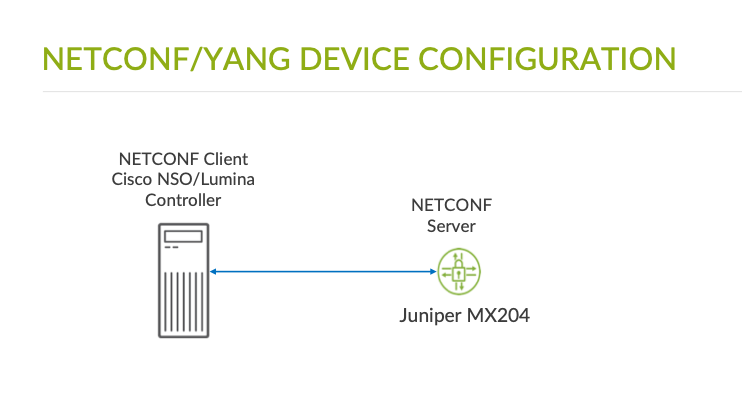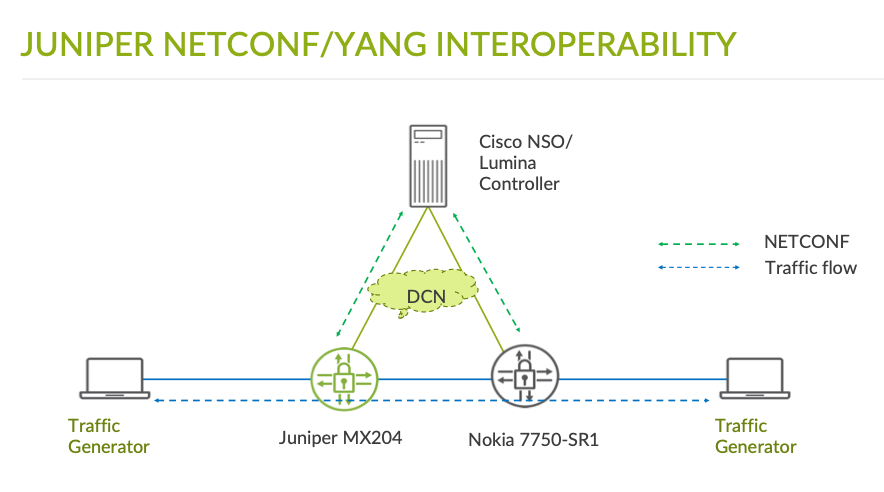This is the fifth in a series of seven blogs that focus on several areas of interoperability testing, including Segment Routing, EVPN, SDN Controllers, Network Automation and Timing & Synchronization. The test report is publicly available and can be found here. See part four on SDN controllers here.
In March 2020, Juniper Networks participated in the EANTC MPLS+SDN+NFV World Congress interoperability event, held in Berlin, to demonstrate a wide array of interoperability use cases. This blog highlights the interoperability events with respect to the SDN controller and Network Configuration Protocol (NETCONF)/Yang tests.
As we enter the era of cloud networking, operational agility, flexibility and scalability are table stakes in the deployment, management and maintenance of networking infrastructure. Additionally, the networking world is marching rapidly toward an automated, open standards and programmable management and maintenance model to keep operational expenses reasonable. Network operators worldwide understand the need to make their networks modular and programmable.
As network architectures evolve, there is a need to leave behind dated techniques such as SNMP and CLI, and embrace modern, model-driven automation approaches that leverage APIs to provide greater network programmability. Juniper has always advocated programmability and has been instrumental in providing a rich suite of automation capabilities and open models in Junos devices. This enables service providers and enterprises alike to have the ability to automate business-critical networking infrastructure and services.
NETCONF/Yang: An Enabling Technology
The IETF standard NETCONF protocol, pioneered by Juniper Networks in 2006, provides a simple mechanism to install, modify and delete the configuration of network devices. NETCONF coupled with standard modeling language and yet another next-generation modeling language (Yang), together provide powerful mechanisms for operators to automate their networks, replacing specific multi-vendor device requirements of the underlying infrastructure.
Today, there is an increasing demand to push NETCONF and Yang standards into vendor network devices, without which, automation capabilities would be crippled. Juniper’s decades of experience in programmability and automation have ensured a continuous effort in complying with standards to support vendor interoperability.
As part of the SDN Controller tests that were conducted at the event, we displayed extensive support of NETCONF and Yang standards on Junos devices. The goal of each test case detailed below was provided by EANTC.
Device Configuration Using NETCONF/Yang
In any SDN environment, for multi-domain and multi-vendor orchestrators to be able to successfully provision and control the underlying network, one of the key requirements is the support and availability of NETCONF and Yang on the networking devices. The goal of this test was to define a set of configurable elements on the networking device and to use the NETCONF protocol to re-provision the parameters on the device.
Juniper MX204 was used to demonstrate interoperability with the Cisco Network Service Orchestrator (NSO) and an open source SDN controller – the Lumina SDN Controller. The Cisco NSO and Lumina SDN controllers were used as NETCONF clients in different instances and the Juniper MX204 router was used as a NETCONF server.

The testing included the following aspects:
- Establish a NETCONF connection between the NETCONF client and the server.
- Retrieve the running configuration, interface configs from the device.
- Execute basic configurations such as static route setup on the device.
- Retrieve and show device capabilities such as operational state and modifying configurations.
- Terminate NETCONF connection.
L2VPN and L3VPN Services Creation Using NETCONF/Yang
The test objective was to verify that a Yang model can be used to configure and manage L2VPNs and L3VPNs. A NETCONF compliant client had to be used as a centralized controller to configure a group of PE nodes and provision L2VPN/L3VPN services.
The Cisco NSO was used as a NETCONF client, with the Juniper MX204 as one of the PE devices and a Nokia 7750-SR1 as the second PE device. Junos Yang models were used by the Cisco NSO to configure and manage L2VPN/L3VPN service on the Juniper MX204. Both VPLS-specific parameters, as well as BGP-specific parameters for L2VPNs and L3VPNS were verified.

The test included the following aspects:
- Establish a NETCONF session between the controller and both the PE devices.
- Controller initiated a VPWS-L2VPN instance configuration on the Junos device and the other PE device.
- Juniper MX204 indicated that the service status was up after the service was established successfully.
- Traffic flow was seamless between both the PE devices validating the NETCONF session.
- Finally, the controller deleted the configurations for a successful session tear down.
EVPN Service Creation Using NETCONF/Yang
The test objective was to use a Yang model to configure and manage BGP EVPNs.
- The Cisco NSO and Lumina Controller were used as NETCONF clients, while the Juniper MX204 was used as one of the PE devices and the Nokia 7750-SR1 was used as a second PE device.
- The test process was similar to the L2VPN/L3VPN test cases. MPLS/VXLAN specific parameters, as well as BGP-specific parameters for EVPN, were verified.
- The Juniper MX204 successfully established NETCONF sessions, allowed EVPN configurations with Yang model, indicated the session status, traffic flow, and followed by service deletion.
Juniper Technology Fuels the ‘Cloud + 5G + AI’ Era Transformation
With open, interoperable solutions, Juniper is providing a new generation of networking infrastructure to help our customers succeed in the ‘Cloud + 5G + AI’ era, including:
- Multi-vendor, interoperable NETCONF/Yang implementation on MX routers
- NETCONF/Yang tested in multi-vendor topology with the following features:
- Interop with the Cisco NSO & Lumina Controller
- L2VPN Service Creation
- L3VPN Service Creation
- BGP EVPN Service Configuration and Management
Innovations like these don’t always capture the headlines. But talk to service providers and you’ll quickly realize that this is where the real revolution begins – in the trenches. In our next blog, we will detail the deep telemetry that network automation requires.
Explore automated next-generation data center operations and join interactive breakout sessions at our Juniper Virtual Summit on June 10 (US/EMEA) and June 11 (APAC).

























